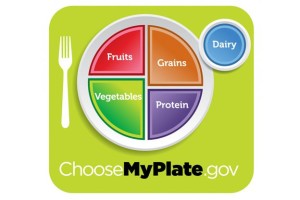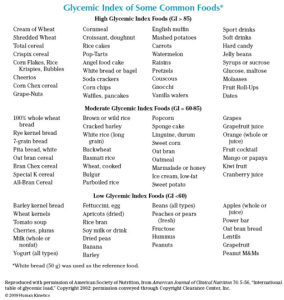What is a carbohydrate?
Carbohydrates are groups of molecules composed of carbon, hydrogen, and oxygen atoms. Someone may commonly think of bread when you think of carbohydrates. But there are so many other foods that are considered carbohydrates: fruits, vegetables, grains, candy; really anything containing sugar. Our bodies use carbohydrates to provide energy to the body. In fact, carbs are the body’s preferred energy source. They are the only macronutrient that the body can use for both aerobic and anaerobic metabolism (i.e. they can provide energy for both short and long duration events). One gram of carbohydrates provides four calories of energy. It is recommended that carbohydrates make up 50-60% of one’s diet (See Figure 1 Grains + Fruits + Vegetables)
All carbs are not created equal!
From a nutritional standpoint, the glycemic index (GI) is important to consider when choosing what carbohydrates to eat and when. The glycemic index is a ranking system that is used to compare the glycemic impact of foods. High glycemic index (HGI) foods are ones that are digested quickly and rapidly appear in the bloodstream as glucose. Low glycemic index (LGI) foods are just the opposite: they are digested slowly and appear in the bloodstream at a slower rate.
The glycemic index is based on a standard white bread that is given a GI of 100. Foods with a GI >85 are considered high, and foods with a GI <60 are considered low. Anything in between 60-85 is considered moderate (MGI).
Examples of HGI: Cheerios, pop tarts, carrots, pretzels, jelly beans, waffles, etc.
Examples of MGI: popcorn, oatmeal, wheat, grapes, sweet potatoes, pita bread, etc.
Examples of LGI: milk, beans, hummus, bananas, rice bran, etc.
(See Figure 2 below for more examples.)
So…what’s better for me?
ALL OF THE ABOVE (within moderation*)! The important thing to remember with different glycemic index carbs is how to time your intake with your energy expenditure. So if you need energy rapidly, for a short duration, it is a good idea to eat a high glycemic carbohydrate. If you need lasting energy over a long duration, lower glycemic index carbohydrates are the way to go. Moderate glycemic index carbs are good to give you a kick-start of energy that will last longer than a HGI carb energy will.
*Moderation
As mentioned above, not all carbs are created equal, and carbs can be good for you at all GI levels. However, few, if any, foods are solely composed of carbohydrates. Therefore it is important to choose your carbohydrates carefully. For example, both soft drinks and shredded wheat are considered high glycemic index carbs. It is well known that shredded wheat is “healthier” than a soft drink. Why? The complexity and additional components. Carbohydrates have different levels of complexity depending on their chemical structure. Typically, the more complex the carbohydrate, the better it is for you. In this case, shredded wheat is a more complex carbohydrate. Soft drinks contain simple sugars that are not very nutritious. Also, the other components in soda (chemicals, etc.) decrease the health value of the drink.
Erin Blaser, BA (University of North Carolina Chapel Hill)
(Figure 2)


